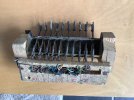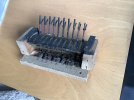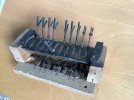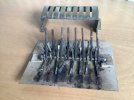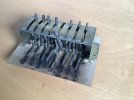JimmyB
Now retired - trains and fishing
As part of my latest extension I have four points (turnouts) to provide moving between parallel tracks (photo below). Previously my points have be electronically controlled either by R/C (Revo), or remote switches. However, due to the location (a distance from my power supply) and the fact I don't envisage these being used much, and am considering using manual control, and possibly a small lever frame close by, connected by rodding. I have seen the Bowden cable method, and this is a second choice, by as I have said my first choice is cracks and rodding. So advice please and parts and suppliers please.




